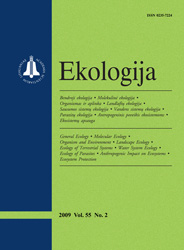 ISSN 0235-7224 ISSN 2029-0586 (online) |
2008 m. Nr. 1 Polymorphism of Lithuanian Scots pine (Pinus sylvestris)
with regard to monoterpene composition in needles
Interspecific interactions between Scots pine and other organisms depend much on tree chemistry, and monoterpenes play an important role in the interactions. Monoterpenes present in pine needles perform a defensive function against phytophagous animals (insects, molluscs, moose, deer) and the function of kairomones and synomones. A pilot study on the composition of monoterpenes in needles of 7–10-year old trees of Scots pine (Pinus sylvestris) from the Lithuanian population (within a relatively small area) was carried out using gas chromatography. The composition of 6 monoterpenes (α-pinene, camphene, β-pinene, myrcene, 3-carene and limonene) in needles was analysed, and the polymorphism of Scots pine was evaluated. With regard to monoterpene composition in needles, Scots pine were found to be polymorphic. The predominant monoterpenes were α-pinene and 3-carene. Th eir relative contents (of all the monoterpenes studied) varied from 27 to 79% and from 0 to 66%, respectively. Relative contents of α-pinene, 3-carene and β-pinene were found to be the most and those of myrcene and camphene the least variable. The relative content of limonene in needle extracts varied moderately. The variation in the relative content of 3-carene was found to be the greatest: in needles of some plants 3-carene was abundant (about 65.8% of the total amount of all the monoterpenes analysed), while in those of other plants this monoterpene was totally absent (or its content was below the level of chromatographic detection). The relative monoterpene composition in needles of Scots pine can be used for plant selection as well as for chemotype identifi cation within the population. Keywords: Pinus sylvestris, population, diversity, secondary metabolites, α-pinene, β-pinene, camphene, myrcene, 3-carene, limonene, monoterpene variation |
Issues:
2011 - Vol.57 No. 1, No. 2 2010 - Vol.56 No. 1-2, No. 3-4 2009 - Vol.55 No. 1, No. 2, No. 3-4 2008 - Vol.54 No. 1, No. 2, No. 3, No. 4 2007 - Vol.53 No. 1, No. 2, No. 2.priedas, No. 3, No. 4 2006 No. 1, No. 2, No. 3, No. 4 2005 No. 1, No. 2, No. 3, No. 4 2004 No. 1, No. 2, No. 3, No. 4 2003 No. 1, No. 2, No. 3, No. 4 2002 No. 1, No. 2, No. 3, No. 4 2001 No. 1, No. 2, No. 3, No. 4 |